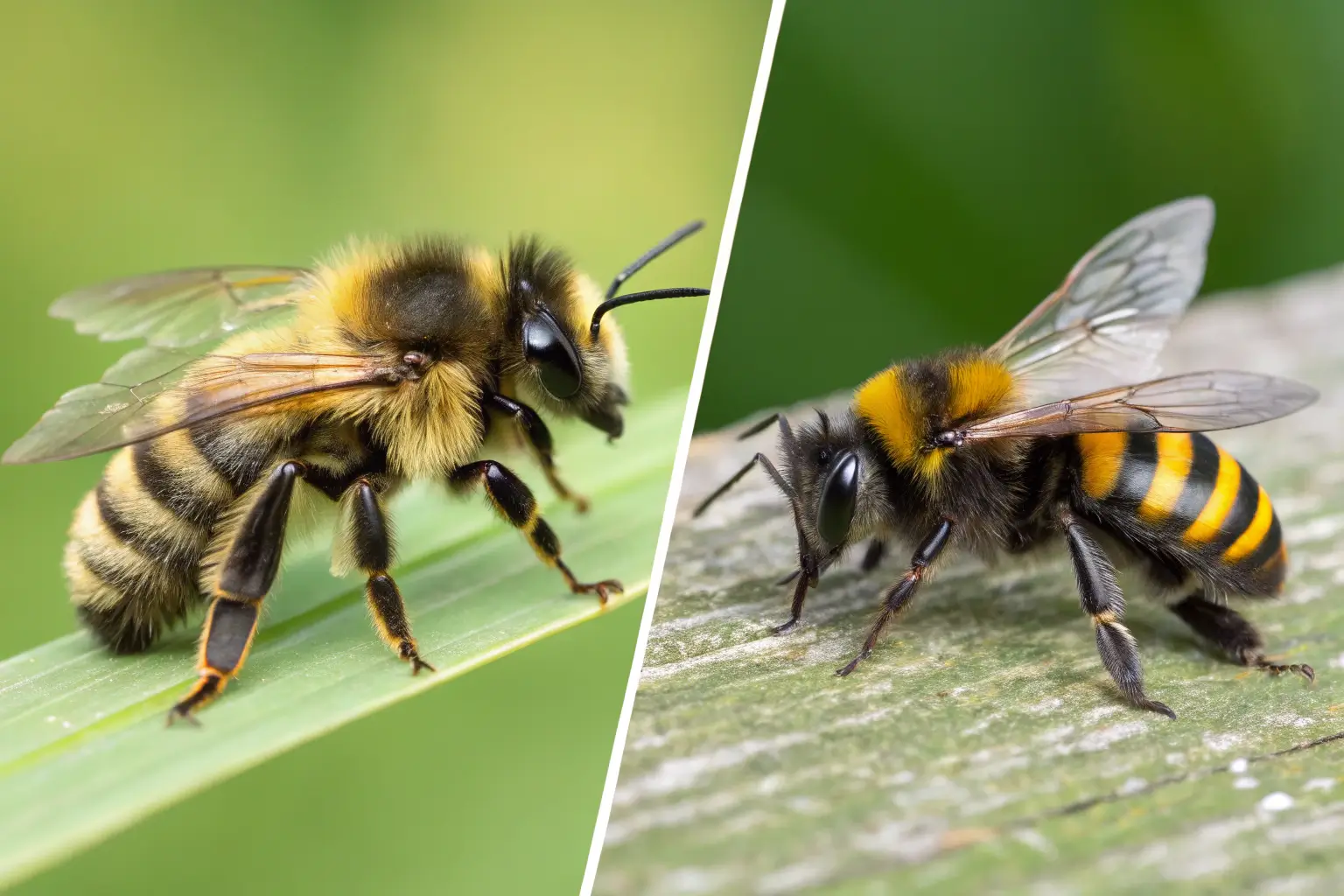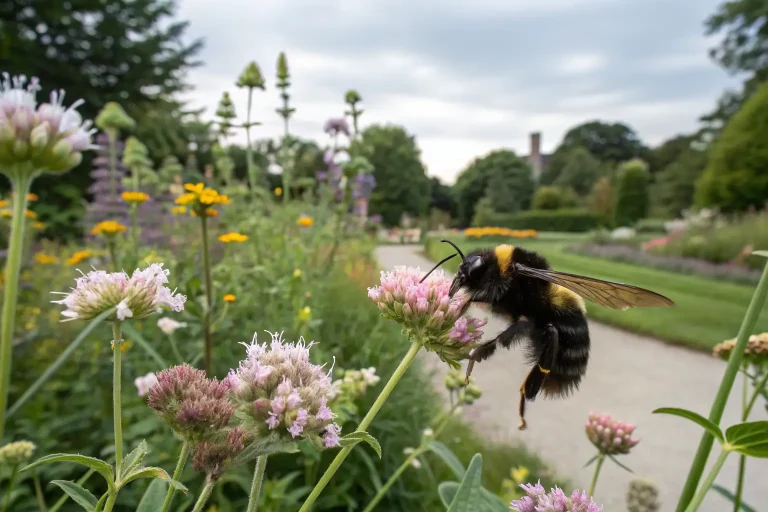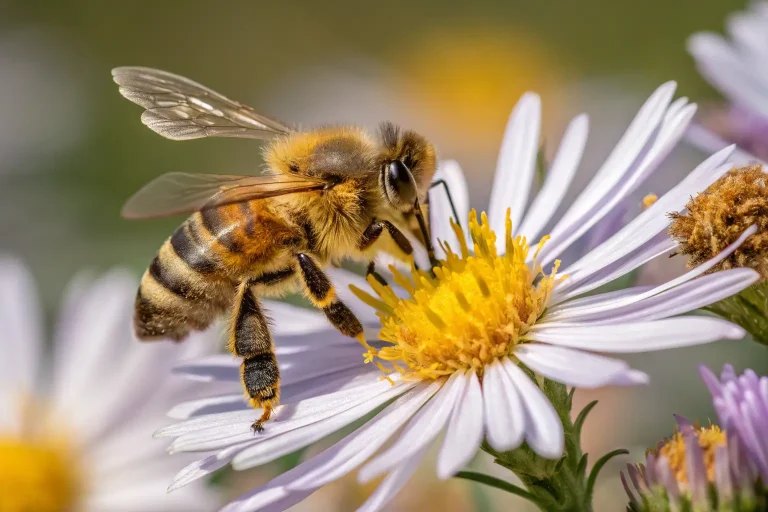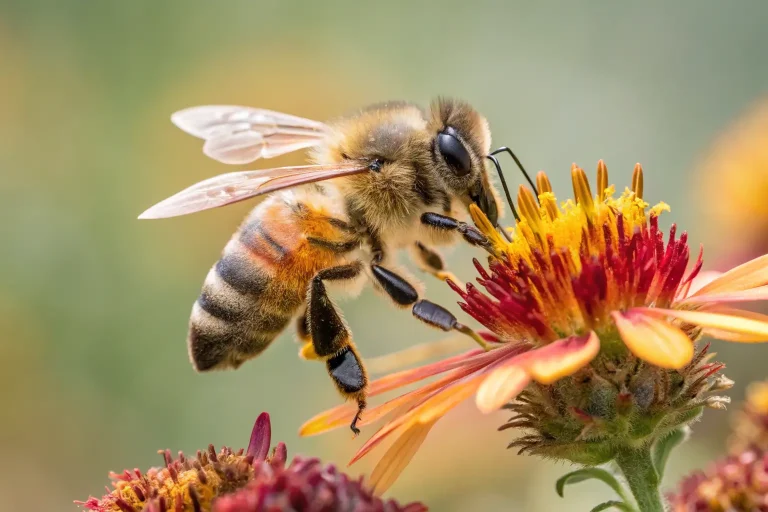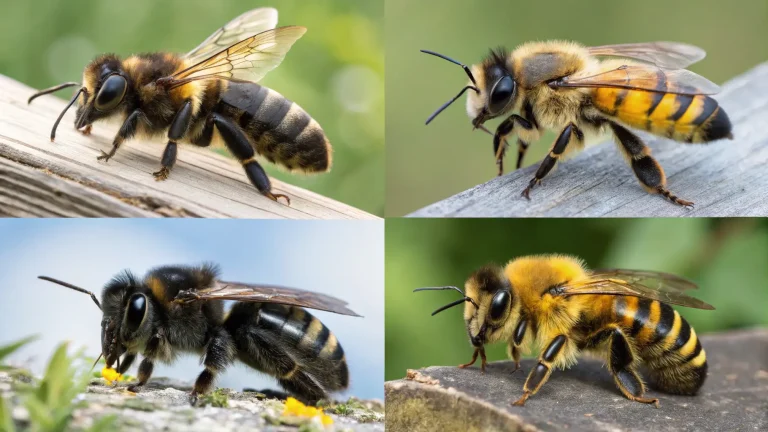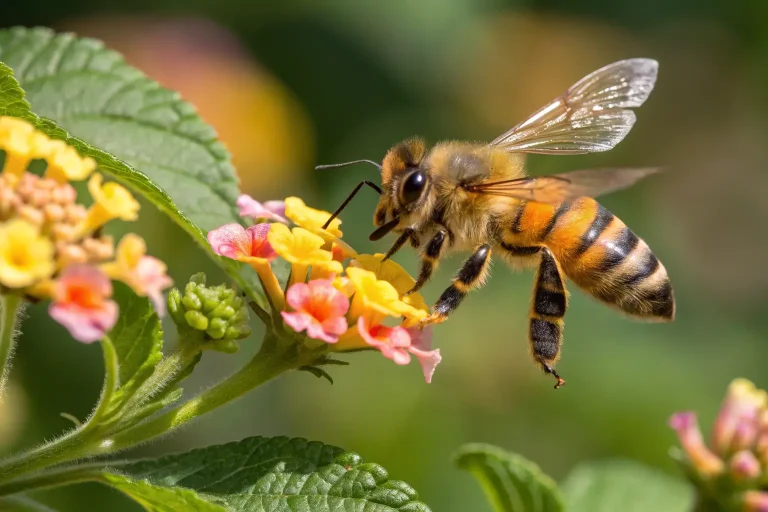Bumblebee vs Honeybee: 7 Key Differences Explained
Have you ever wondered about the differences between a bumblebee and a honeybee as they buzz around your garden? These fuzzy fliers might seem similar at first glance, but distinguishing between bumblebee vs honeybee species reveals fascinating contrasts in their appearance, behavior, and ecological roles. Whether you’re a gardening enthusiast, concerned about bee conservation, or simply curious about these remarkable pollinators, understanding these differences can enrich your appreciation of these vital insects. In this comprehensive guide, we’ll explore seven key distinctions that set these buzzing beauties apart and provide essential insights for identification and appreciation.
Introduction
Bees represent some of nature’s most industrious and beneficial insects, with bumblebees and honeybees standing out as the most recognizable varieties. These incredible pollinators are responsible for the reproduction of countless plant species, including many of the fruits and vegetables we consume daily.
Learning to distinguish between bumblebee vs honeybee characteristics is more than just an interesting nature lesson—it’s increasingly important for ecological awareness. With global bee populations facing serious threats from pesticides, habitat loss, and climate change, being able to identify different bee species contributes to conservation efforts and helps us better protect these essential pollinators.
Did you know that a single honeybee might visit up to 5,000 flowers in a single day, while a bumblebee’s larger body and longer tongue allow it to pollinate flowers that honeybees can’t access? This complementary relationship is just one example of why both bee types are critical to healthy ecosystems.
Species Overview
Scientific Name
Bumblebees belong to the genus Bombus and comprise over 250 species worldwide. Common bumblebee species include Bombus terrestris (buff-tailed bumblebee) and Bombus impatiens (common eastern bumblebee).
Honeybees, on the other hand, belong to the genus Apis, with Apis mellifera (western honeybee) being the most widely managed bee species globally for honey production and crop pollination.
Physical Characteristics
When comparing bumblebee vs honeybee appearance, several distinctions become evident:
Bumblebees:
- Larger, rounder bodies (approximately 0.6-1 inch long)
- Robust build with a “fuzzy” appearance due to dense hair covering
- Black body with distinctive yellow, orange, or white bands
- Shorter, rounder wings relative to body size
- Rounded rear legs for collecting pollen
Honeybees:
- Smaller, slimmer bodies (approximately 0.5 inches long)
- Less hairy appearance with a more slender waist
- Golden-brown to yellow-black coloration
- Longer, more translucent wings
- Flattened rear legs with specialized “pollen baskets”
Subspecies
Bumblebees display remarkable diversity, with species adapted to environments ranging from arctic tundra to tropical forests. Notable variations include the rusty-patched bumblebee (Bombus affinis), now endangered in North America, and the large garden bumblebee (Bombus ruderatus), which features distinctive yellow and black stripes.
The western honeybee (Apis mellifera) has approximately 24 recognized subspecies, including the Italian honeybee (A. m. ligustica), prized for its gentle temperament and honey production, and the Carniolan honeybee (A. m. carnica), valued for its winter hardiness and disease resistance.
Habitat and Distribution
Natural Habitat
The bumblebee vs honeybee habitat preferences reveal important ecological differences:
Bumblebees typically nest underground in abandoned rodent burrows, under piles of plant debris, or occasionally in bird boxes. Their colonies are much smaller than honeybees, usually housing just 50-400 bees. Bumblebees prefer diverse landscapes with abundant flowering plants, including meadows, woodlands, gardens, and agricultural fields.
Honeybees naturally nest in tree cavities and rock crevices, though domesticated colonies live in human-provided hives. Their complex hives can house tens of thousands of bees. Honeybees thrive in varied habitats from forests to urban environments, provided there are adequate flowering resources within their 2-3 mile foraging range.
Geographic Range
Bumblebees have a primarily Northern Hemisphere distribution, with the greatest diversity in temperate regions. They’re found across North America, Europe, and Asia, with a few species extending into South America. Their ability to regulate body temperature through metabolic heat allows them to operate in cooler climates than most bee species.
Honeybees originated in Africa, Europe, and Western Asia but have been introduced globally. They’re now found on every continent except Antarctica, though they require human management in many regions. Different subspecies have adapted to various climate zones, from Mediterranean to alpine environments.
Adaptations
Bumblebee adaptations:
- Thermoregulation through “shivering” wing muscles allows foraging in cooler temperatures
- Longer tongues enable pollination of deep-throated flowers
- Dense fur provides insulation for cold-weather activity
- Ability to sonicate or “buzz pollinate” flowers that require vibration to release pollen
Honeybee adaptations:
- Sophisticated communication through waggle dances to indicate food sources
- Propolis collection for hive sanitization and protection
- Efficient thermoregulation through collective behaviors
- Elaborate honey storage systems for surviving seasonal food scarcity
Diet and Feeding Habits
What They Eat
Both bumblebee and honeybee diets consist primarily of:
- Nectar: Provides carbohydrates and energy
- Pollen: Supplies protein, fats, and micronutrients
However, their handling of these resources differs considerably in the bumblebee vs honeybee comparison:
Bumblebees store only small amounts of honey and pollen, typically just enough to sustain the colony for a few days. They consume nectar directly and collect pollen in a damp mass on their hind legs.
Honeybees convert nectar into honey through enzymatic processes and evaporation, storing substantial reserves to survive winters. A typical honeybee colony might produce 60-100 pounds of honey annually. They also process pollen into “bee bread” by mixing it with nectar and beneficial microbes for preservation.
Foraging Behavior
Bumblebee foraging:
- Can fly in cooler temperatures (as low as 50°F/10°C)
- Often active earlier in morning and later in evening
- Typically forage within a 1-mile radius of nest
- Demonstrate flower constancy but may switch to more rewarding plant species
- Can visit 20-30 flowers per minute due to their efficient foraging
Honeybee foraging:
- Require warmer conditions (above 55°F/13°C)
- Most active during midday hours
- Can forage up to 3 miles from hive
- Use elaborate communication to recruit nestmates to productive flower patches
- Typically specialize in either nectar or pollen collection during a foraging trip
Dietary Needs
Both bee types require diverse floral resources throughout their active seasons, but their specific nutritional requirements differ:
Bumblebees need continuous flower availability from early spring through fall to support their annual colonies. Their larger bodies require more energy, making them prodigious nectar consumers.
Honeybees require year-round resources in warmer climates or sufficient stores for winter survival in temperate regions. Their perennial colonies maintain consistent nutritional needs across seasons, with increased protein requirements during brood-rearing periods.
Behavior and Social Structure
Social Behavior
The bumblebee vs honeybee social organization represents different evolutionary strategies:
Bumblebees form annual colonies with a simpler social structure:
- Colonies last one season, with only new queens overwintering
- Colony population typically ranges from 50-400 bees
- Less rigid division of labor among workers
- Queen establishes the nest alone in spring and initially raises the first worker brood
- Males (drones) and new queens are produced at the end of the season
Honeybees maintain perennial colonies with complex social organization:
- Colonies can persist for years
- Population ranges from 20,000-80,000 bees per colony
- Highly specialized division of labor based on age and genetic factors
- Workers progress through a series of roles from hive maintenance to foraging
- Swarm reproduction involves the original queen leaving with workers to establish new colonies
Communication
Bumblebee communication:
- Primarily chemical through pheromones
- Simple acoustic signals through buzzing
- Lacks the sophisticated recruitment dances of honeybees
- Information about food sources spreads through observation and scent learning
Honeybee communication:
- Complex symbolic “language” through waggle dances
- Conveys precise information about direction, distance, and quality of resources
- Intricate pheromone systems for colony coordination
- Specialized antenna movements and vibration signals for in-hive communication
- Collective decision-making processes for tasks like nest-site selection
Mating and Reproduction
The reproductive strategies show significant differences in the bumblebee vs honeybee comparison:
Bumblebees:
- Queens mate with several males in autumn
- Mated queens hibernate alone through winter
- Spring colony founding by single queen
- Queens can live for one year
- Males die after mating
- Workers live 2-6 weeks during active season
Honeybees:
- Queens mate with 12-20 males during nuptial flights
- Queens can live 2-5 years, continuously laying up to 2,000 eggs daily
- No hibernation period for the colony
- New queens are raised in special queen cells when the colony prepares to swarm
- Workers live 4-6 weeks during summer, several months during winter
- Males die after mating or are expelled from the hive before winter
Conservation Status
Endangerment Level
According to the International Union for Conservation of Nature (IUCN), both bee types face significant challenges:
Bumblebees have several endangered species, including the Franklin’s bumblebee (Bombus franklini), which may be extinct, and the rusty-patched bumblebee (Bombus affinis), listed as critically endangered. Approximately 25% of North American bumblebee species face some level of extinction risk.
Honeybees, while managed globally, face serious population pressures. Though the western honeybee (Apis mellifera) isn’t listed as endangered, annual colony losses of 30-40% in North America and similar declines elsewhere represent significant threats to both wild and managed populations.
Threats
Both bee types face similar threats, though with varying impacts:
Shared threats in the bumblebee vs honeybee survival challenges:
- Habitat loss and fragmentation
- Pesticide exposure, particularly neonicotinoids
- Climate change altering flowering times and habitats
- Diseases and parasites
- Reduced floral diversity
Bumblebee-specific threats:
- More vulnerable to habitat fragmentation due to limited flight range
- More susceptible to climate change due to narrow temperature tolerances of some species
- Less research and monitoring compared to honeybees
Honeybee-specific threats:
- Colony Collapse Disorder (CCD)
- Varroa mite infestations
- Intensive agricultural management practices
- Transportation stress from commercial pollination
Conservation Efforts
Efforts to protect both bee types include:
Bumblebee conservation:
- The Bumblebee Conservation Trust’s habitat restoration projects
- Xerces Society’s endangered species protection programs
- Citizen science monitoring programs like BeeWatch and Bumble Bee Watch
- Research into disease resistance and conservation breeding
Honeybee conservation:
- Beekeeping associations providing education and disease management
- Restrictions on neonicotinoid pesticides in the EU and parts of North America
- Urban beekeeping initiatives increasing public awareness
- Research into disease-resistant bee breeding
Shared conservation strategies:
- Pollinator-friendly planting guides for gardeners and landowners
- Establishment of pollinator corridors and habitat reserves
- Integrated Pest Management promoting reduced pesticide use
- Policy advocacy for bee-friendly agricultural practices
Interesting Facts
When it comes to bumblebee vs honeybee fascinating features, both have remarkable abilities that showcase their evolutionary success:
Bumblebee marvels:
- Can produce body heat through muscle contractions, allowing them to fly in temperatures as low as 50°F when other insects remain grounded
- Queens can store sperm for months during hibernation before using it to fertilize eggs
- Some species have tongues nearly as long as their bodies for accessing deep flower nectar
- Buzz pollination creates a specific frequency that releases pollen from certain flowers like tomatoes and blueberries
- Can recognize and remember individual flowers they’ve visited
Honeybee wonders:
- A worker bee will produce approximately 1/12 teaspoon of honey in its lifetime
- Honeybees maintain their hive temperature at a precise 93-95°F year-round through collective behavior
- The queen can lay her own body weight in eggs daily during peak season
- Honey found in Egyptian tombs over 3,000 years old remains edible due to its antimicrobial properties
- Forager bees can calculate the most efficient routes between multiple flower patches, solving the complex “traveling salesman problem”
Cultural significance:
- Bumblebees have featured prominently in children’s literature and folklore, often symbolizing industriousness and community
- Honeybees appear in ancient Egyptian hieroglyphs, Greek mythology, and as symbols in numerous religions
- The phrase “busy as a bee” reflects humanity’s long appreciation for these insects’ work ethic
Tips for Supporting Wild Bees
While neither bumblebees nor honeybees make suitable pets, there are many ways to support wild populations:
Create bee-friendly gardens:
- Plant native flowers that bloom in succession throughout the growing season
- Include tubular flowers for bumblebees and open-faced flowers for honeybees
- Avoid pesticides, especially neonicotinoids
- Provide shallow water dishes with pebbles as landing spots
Support bumblebee nesting:
- Leave areas of unmown grass or leaf litter
- Install bumblebee nest boxes in sheltered locations
- Avoid disturbing ground nests if discovered
- Create “messy corners” in gardens with natural materials
Assist honeybee populations:
- Consider backyard beekeeping with proper training
- Support local beekeepers by purchasing honey and beeswax products
- Report feral swarms to local beekeeping associations for collection
- Plant high-nectar flowers like lavender, borage, and linden trees
Health considerations:
- Both bee types rarely sting unless threatened
- Bumblebees can sting multiple times, while honeybee workers die after stinging
- If allergic to bee stings, carry appropriate medication and wear protective clothing when gardening
Role in the Ecosystem
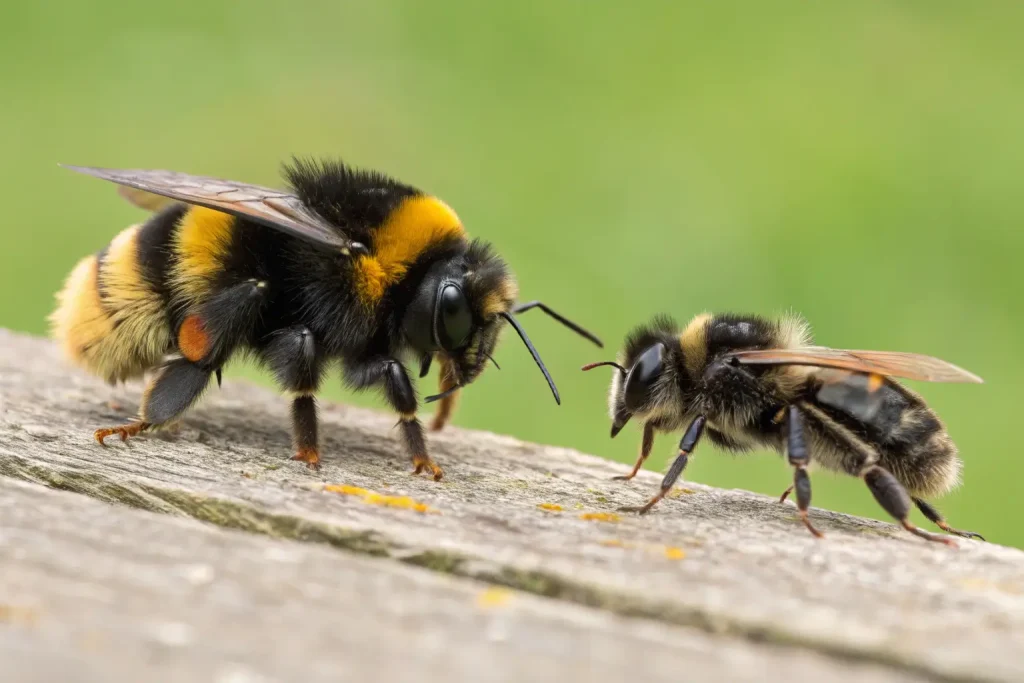
Ecological Importance
The bumblebee vs honeybee ecological contributions highlight their complementary roles:
Bumblebee contributions:
- Pollinate plants honeybees cannot access due to flower shape or bloom time
- Active in cold, wet conditions when other pollinators remain inactive
- Crucial pollinators for wildflowers, berries, and certain commercial crops like tomatoes and peppers
- Provide “buzz pollination” essential for approximately 8% of the world’s flowering plants
- Less affected by rain, allowing pollination during inclement weather
Honeybee contributions:
- Pollinate approximately one-third of global food crops
- High population density makes them efficient mass-pollinators
- Communication system allows rapid mobilization to flowering crops
- Managed hives can be transported to provide pollination services
- Honey production creates ecological buffers against seasonal food scarcity
Together, these bee types ensure resilient pollination networks that support entire ecosystems.
Impact of Decline
The potential consequences of continued bumblebee vs honeybee population declines include:
Environmental impacts:
- Reduced plant diversity and productivity in natural ecosystems
- Cascading effects on wildlife dependent on bee-pollinated plants
- Disruption of mutually beneficial plant-pollinator relationships developed over millions of years
- Potential local extinctions of plant species with specific pollinator needs
Economic impacts:
- Annual global pollination services are valued at $235-577 billion
- Increased food costs as manual pollination becomes necessary
- Reduced crop yields and quality in bee-dependent agriculture
- Threats to food security and nutritional diversity
Societal impacts:
- Loss of traditional knowledge and practices related to beekeeping
- Reduced availability of honey, beeswax, and other hive products
- Potential impacts on human health through reduced food diversity
- Cultural losses as bee-related traditions and crafts decline
Conclusion
The bumblebee vs honeybee comparison reveals two remarkable insect types that, despite their differences, share crucial ecological roles. Bumblebees, with their larger bodies, annual colonies, and cold-weather capabilities, complement the highly organized, perennial colonies of honeybees with their elaborate communication and honey-producing abilities.
Understanding these distinctions helps us appreciate how each bee type fills a specific ecological niche. While honeybees excel at mass-pollinating many commercial crops, bumblebees access flowers that honeybees cannot, ensuring comprehensive pollination services across diverse ecosystems.
As we face continued challenges to bee populations worldwide, this knowledge becomes increasingly important. By recognizing the unique contributions and needs of different bee species, we can develop more effective conservation strategies.
Each of us can take simple actions to support these essential pollinators: planting diverse native flowers, reducing pesticide use, providing nesting habitat, and raising awareness about the importance of bees. Through these collective efforts, we can help ensure that both bumblebees and honeybees continue to buzz through our gardens and natural landscapes for generations to come.
Frequently Asked Questions
Which is more aggressive, bumblebees or honeybees?
Neither bee type is naturally aggressive. Bumblebees are generally docile and sting only when their nest is threatened or they’re handled roughly. Honeybees are similarly non-aggressive away from their hive, though they may become defensive when protecting their colony. Honeybees have barbed stingers that remain in mammalian skin, causing the bee’s death after stinging, while bumblebees can sting multiple times if provoked.
Can I keep bumblebees for honey production?
No, bumblebees produce only small amounts of a honey-like substance for their own consumption. They don’t create excess honey stores like honeybees. Bumblebee colonies are also annual, unlike the perennial honeybee colonies that accumulate honey reserves for winter survival. Commercial honey comes exclusively from honeybees.
How can I tell the difference between a bumblebee and a honeybee in my garden?
Look for size and shape differences—bumblebees are larger, rounder, and much fuzzier than honeybees. Bumblebees have a more circular appearance in flight, while honeybees are more elongated with visible “waists.” Bumblebees often fly in a more meandering pattern, while honeybees typically take more direct flight paths. Bumblebees also make a louder, lower-pitched buzzing sound compared to honeybees.
Do bumblebees and honeybees compete with each other?
There can be some competition for floral resources, especially in areas with limited flower diversity. However, research suggests they generally occupy different ecological niches due to their physical and behavioral differences. Bumblebees often visit different flower types than honeybees, forage in different weather conditions, and have different tongue lengths. Maintaining diverse flowering plants helps reduce competition.
What should I do if I find a bee swarm or nest?
For honeybee swarms, contact a local beekeeper or beekeeping association—these are valuable and can usually be collected and rehomed. Never disturb or destroy a honeybee swarm. For bumblebee nests, simply leave them undisturbed; they’ll naturally die out in autumn except for new queens who hibernate elsewhere. If a nest must be moved due to safety concerns, professional removal is recommended.
Are all bees declining at the same rate?
No, decline patterns vary significantly by species and region. Some bumblebee species have declined by up to 87% in recent decades, while others remain relatively stable. Managed honeybee populations fluctuate with beekeeping practices, but many regions report concerning winter losses exceeding 30%. Wild honeybee populations have declined substantially in North America and Europe. Overall, approximately 40% of all bee species worldwide face population challenges.
Can I help bees if I live in an apartment without a garden?
Absolutely! You can grow bee-friendly flowers in balcony planters or window boxes, support organizations working on bee conservation through donations, purchase honey from local sustainable beekeepers, reduce pesticide use in your living spaces, and participate in citizen science projects monitoring local bee populations. Even spreading awareness about bee conservation through social media and conversations makes a valuable contribution.

